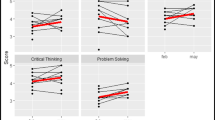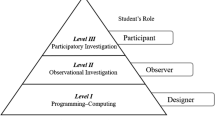Abstract
This paper presents a middle school human-centered robotics (HCR) learning experience and the ways in which it supported students’ orientation to technical and social aspects of Science, Technology, Engineering, and Mathematics (STEM). The interdisciplinary project associated with this analysis aims to engage diverse students in authentic STEM practices by creating robotic technologies that can assist people in their school, and connect with remote peers. The goal of this project is to increase student interest in and knowledge of STEM topics, and to help students recognize STEM as relevant to their daily lives and broader societal issues. The human-centered focus of the curriculum encouraged thinking from multiple perspectives (e.g. design, social science, programming) and allowed for diverse STEM exploration. We present samples from student work and classroom interactions. These samples show challenges and successes in engaging students with STEM as a combination of social and technical questions and skills. We trace the trajectory of one group’s work to highlight moments in which students navigated an engineering design cycle, analyzed and designed social environments, and crossed disciplinary domains through HCR design—using a phenomena, mechanisms, components framework (PMC) to explore systems thinking. Phenomena refers to attention to the function of the robotic technology in the classroom environment. Components included a focus on single parts of the robot, while mechanism addressed how parts of the robot worked together. This qualitative case study demonstrates the capacity social robotics and inquiry-based learning experiences hold for broadening notions of STEM as a social and multidisciplinary learning domain.











Similar content being viewed by others
Notes
All students have been given pseudonyms.
References
Barker BS, Ansorge J (2007) Robotics as means to increase achievement scores in an informal learning environment. J Res Technol Educ 39:229–243
Weinberg JB, Pettibone JC, Thomas SL, Stephen ML, Stein C (2007) The impact of robot projects on girls’ attitudes toward science and engineering. In: Robotics science and systems (RSS) workshop on research in robots for education. Georgia Institute of Technology, Atlanta, GA, 30 June 2007
Mataric MJ, Koenig NP, Feil-Seifer D (2007) Materials for enabling hands-on robotics and STEM Education. In: AAAI spring symposium: semantic scientific knowledge integration, pp 99–102
Williams D, Ma Y, Prejean L (2010) A preliminary study exploring the use of fictional narrative in robotics activities. J Comput Math Sci Teach 29(1):51–71
Robinson LE, Whittier M (2007) Teaching evolution to non-English proficient students by using Lego robotics. Am Second Educ 35(3):19–28
Scassellati B, Admoni H, Matarić M (2012) Robots for use in autism research. Annu Rev Biomed Eng 14:275–294
Hamner E, Lauwers T, Bernstein D, Nourbakhsh IR, DiSalvo CF (2008) Robot diaries: broadening participation in the computer science pipeline through social technical exploration. In: AAAI spring symposium: using AI to motivate greater participation in computer science, pp 38–43
Qidwai UA (2007) A LAMP-LEGO experience of motivating minority students to study engineering. ACM SIGCSE Bull 39(4):41–44
Šabanović S (2010) Robots in society, society in robots. Int J Soc Robot 2(4):439–450
Schaal S (2007) The new robotics: towards human-centered machines. HFSP J 1(2):115–126
Baker D, Leary R (1995) Letting girls speak out about science. J Res Sci Teach 32(1):3–27
DiSalvo C, Nourbakhsh I, Holstius D, Akin A, Louw M (2008) The neighborhood networks project: a case study of critical engagement and creative expression through participatory design. In: Proceedings of the 10th conference on participatory design, Indiana University, pp 41–50
Gomoll A, Hmelo-Silver CE, Šabanović S, Francisco M (2016) Dragons, ladybugs, and softballs: girls’ STEM engagement with human-centered robotics. J Sci Educ Technol 25(6):899–914
Turkle S, Papert S (1992) Epistemological pluralism and the revaluation of the concrete. J Math Behav 11(1):3–33
Hmelo-Silver CE, Duncan RG, Chinn CA (2007) Scaffolding and achievement in problem-based and inquiry learning: a response to Kirschner, Sweller, and Clark (2006). Educ Psychol 42:99–107
Hmelo-Silver CE (2004) Problem-based learning: What and how do students learn? Educ Psychol Rev 16(3):235–266
Hmelo CE, Holton DL, Kolodner JL (2000) Designing to learn about complex systems. J Learn Sci 9(3):247–298
Kolodner JL, Camp PJ, Crismond D, Fasse B, Gray J, Holbrook J, Puntambekar S, Ryan M (2003) Problem-based learning meets case-based reasoning in the middle-school science classroom: putting learning by Design\({}^{{(\rm TM)}}\) into practice. J Learn Sci 12(4):495–547
Buchanan R (1992) Wicked problems in design thinking. Des Issues 8(2):5–21
Blumenfeld PC, Soloway E, Marx RW, Krajcik JS, Guzdial M, Palincsar A (1991) Motivating project-based learning: sustaining the doing, supporting the learning. Educ Psychol 26(3–4):369–398
NGSS Lead States (2013) Next generation science standards: for states, by states. http://www.nextgenscience.org/get-to-know
Resnick M (2007) All I really need to know (about creative thinking) I learned (by studying how children learn) in kindergarten. In: Proceedings of the 6th ACM SIGCHI conference on creativity and cognition. ACM, pp 1–6
Danish JA, Gresalfi MS (2018) Cognitive and sociocultural perspective on learning: tensions and synergy in the learning sciences. In: Fischer F, Hmelo-Silver CE, Goldman SR, Reimann, P (eds) International handbook of the learning sciences. Routledge, New York
Castanheira ML, Green JL, Yeager E (2009) Investigating inclusive practices: an interactional ethnographic approach. In: Kumpulainen K, Hmelo-Silver CE, César M (eds) Investigating classroom interaction: methodologies in action. Sense Publishers, Rotterdam, The Netherlands, pp 145–178
Baker WD, Green JL (2007) Limits to certainty in interpreting video data: interactional ethnography and disciplinary knowledge. Pedagog Int J 2(3):191–204
Powell AB, Francisco JM, Maher CA (2003) An analytical model for studying the development of learners’ mathematical ideas and reasoning using videotape data. J Math Behav 22(4):405–435
Jordan B, Henderson A (1995) Interaction analysis: foundations and practice. J Learn Sci 4(1):39–103
Sinha S, Rogat TK, Adams-Wiggins KR, Hmelo-Silver CE (2015) Collaborative group engagement in a computer-supported inquiry learning environment. Int J Comput Support Collab Learn 10(3):273–307
Kolodner JL (2002) Facilitating the learning of design practices: lessons learned from an inquiry into science education. J Ind Teach Educ 39(3):3. http://scholar.lib.vt.edu/ejournals/JITE/v39n3/kolodner.html
Acknowledgements
We acknowledge the contributions of Haley Molchan, Stella Huang, Charlie Mahoney, AnnaRose Girvin, Miranda Meade, and Ben Oistad who played a key role in the implementation of our curriculum.
Funding
This research was funded by National Science Foundation awards DRL-1433414 and DRL-1433841.
Author information
Authors and Affiliations
Corresponding author
Ethics declarations
Conflicts of interest
The authors declare no other conflicts of interest.
Informed Consent
All participants and their parents/guardians agreed to participate in this study and submitted informed consent forms.
Rights and permissions
About this article
Cite this article
Gomoll, A., Šabanović, S., Tolar, E. et al. Between the Social and the Technical: Negotiation of Human-Centered Robotics Design in a Middle School Classroom. Int J of Soc Robotics 10, 309–324 (2018). https://doi.org/10.1007/s12369-017-0454-3
Accepted:
Published:
Issue Date:
DOI: https://doi.org/10.1007/s12369-017-0454-3




